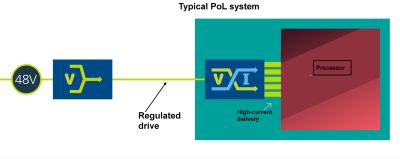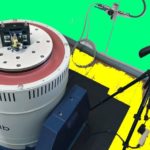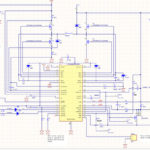New ways of routing power around circuit boards bring more efficiency and fewer thermal problems.
Phil Davies | Vicor Corp.
Power distribution networks (PDNs) are the backbone of any power system. As system power demands rise, traditional PDNs are under tremendous pressure to deliver enough performance. There are two main ways to improve PDN impact on power system performance with regards to power losses and thermal management. Option one, reduce the PDN resistance with larger cables, connectors and thicker motherboard power planes; or option two, boost the PDN voltage to reduce its current for a given power delivery, which can allow use of smaller cables, connectors, motherboard copper planes and their associated size, cost and weight.
For many years engineers have used option one for compatibility with the large ecosystem built up over decades for single-phase ac and 12-V dc-dc converters and regulators. Other reasons include the lack of performance of dc-dc converter topologies that could efficiently convert higher voltages to PoL (point-of-load) directly and the associated expense of these higher-voltage converters and regulators.
However, modern-day power designs increasingly use option two, higher PDN voltage. This trend is driven by the significant rise in system load power. In the case of data centers, the addition of artificial intelligence (AI), machine learning, and deep learning has caused rack power to soar by a factor of two into the 20-kW range; and supercomputer server racks are now approaching 100 kW or more.

This increasing need for power has systems engineers reevaluating their complete PDNs, from the distribution of power to the racks, power distribution within the rack, and even the PDNs on the server blades because modern CPUs and AI processors consume more power. When rack power was at a 5-kW level, single-phase ac to the rack was the norm. The ac was then converted to 12 V for distribution to the server blades. At the 5-kW level the PDN current was 416 A (5 kW/12 V) and power distribution took place via heavy gauge cables.
As processor power started to dramatically rise around 2015, rack power moved up to the 12-kW level. So 1 kA had to be managed within the rack for a 12-V PDN . The OCP (Open Compute Project) consortium — whose membership includes most cloud, server and CPU companies — continued to evolve its 12-V rack design. OCP racks moved from cables to bus bars and distributed multiple single-phase ac-to-12-V converters within the rack to minimize the PDN distance and resistance to the server blades. The major change from prior rack power delivery was that the single-phase ac was derived from the individual phases of a three-phase feed to the rack.
Companies with the ability to build their own racks and data center solutions began to move to 48-V distribution. This strategy cut down the high-current PDN problem to 250 A for a 12-kW rack but brought new challenges to blade power conversion.

As rack power has risen above the 20-kW range, server rack PDN design is continuing to evolve. Attempts to maintain the status quo 12-V legacy systems are creative on many fronts, but the introduction of AI into data centers with processors exceeding 1 kA steady-state with peak currents approaching 2 kA make 12-V-based PDNs impractical. AI is all about performance, and 12-V PDNs limit performance and competitiveness.
To address the many challenges of high-power racks, the OCP consortium is evolving toward racks that accommodate 48-V PDNs. Moving to 48 from 12-V distribution reduces the input current requirement by a factor of 4 (P = V × I) and cuts losses by 16x (power loss = I2R). Moreover, there’s a move to 48-V power distribution in the automotive and 5G markets, LED lighting, display markets, and in industrial applications. Thus the ecosystem of 48-V power converters is rapidly expanding. Moving to 48 V makes good business sense. However, not all 48-V converter topologies and architectures are the same. Performance varies widely in the 48-V converter market, a fact worth carefully considering.
With high-performance and power efficiency at the top of the list of requirements for high-power racks and data centers, several companies are moving to three-phase-ac-to-48-V for distribution to the blades. Alternatively, high-voltage dc (at 380 V, derived from a rectified three-phase feed) distributed within the rack can be used. Several High-Performance Computing (HPC) companies are using HVDC PDNs for racks up to 100 kW.
As PDNs that supply the blades convert to 48 V, power conversion on the blade must change. This shift has led to many alternatives in architecture, topology and packaging of dc-dc converters and regulators.
The 48-V regime is new to data center servers but commonplace in communications applications such as routers and network switches, thanks to their use of -48-V lead-acid rechargeable backup battery systems.
The common architecture traditionally used in data center servers was called the Intermediate Bus Architecture or IBA. IBA consisted of an isolated non-regulated bus converter to convert the –48 V to +12 V which was then fed to a bank of multiphase buck regulators for the points-of-load. Some of the cloud computing companies and HPC companies copied this architecture initially for their 48-V systems, but as power rose and voltage at the PoL dropped to 1 V and below, designers sought out alternative architectures and topologies.
Power system architecture, switching topologies, and packaging are critical to a high-performance, high-density design. As AI and CPU processor currents rise, the density of the power delivery circuits at the PoL becomes the most critical element in AI applications because of the PDN resistance between the regulator and the PoL.
The latest state-of-the-art AI processors have steady state currents of almost 1 kA with peak currents reaching 1.5 kA to 2 kA. Consider that a typical PDN resistance from the output of a conventional multiphase buck regulator to the processor is in the 200 to 400 µΩ range. The resulting power losses in the PCB are 200 – 400 W steady state, too high for any system to handle.
PDN losses become the dominant factor in the efficiency and performance of the dc-dc regulator design. Because this is a point-of-load problem and higher voltage is impractical (PoL voltages are declining rapidly to keep Moore’s law in force), the only reasonable approach is to reduce the PDN resistance, usually by placing the regulator as close as possible to the processor. In the case of a multiphase buck regulator, it typically takes 16 – 24 phases to support the high AI processor current. This is not a high current density approach and does not solve the PDN power loss problem.
Factorized Power Architecture
An alternative to IBA is Vicor’s Factorized Power Architecture (FPA), which consists of a pre-regulation stage (PRM) followed by a voltage-transformation stage (VTM). This proprietary architecture optimizes the performance of each stage. The PRM performs a non-isolated (48 V is Safety Extra Low Voltage, SELV) regulation. It’s 48-V input is tightly regulated to provide a 48-V output, and conversion to the desired PoL voltage takes place in the VTM, which is a fixed ratio (The output voltage is a fixed ratio of the input voltage.) converter.

This architecture and its performance are enhanced by proprietary topologies used within the PRM and VTM. The PRM uses a zero-voltage switching topology while the VTM uses a proprietary resonant high-frequency Sine Amplitude Converter (SAC) topology. Conversion to the PoL voltage uses both zero-voltage and zero-current switching. The VTM is essentially a dc-dc transformer where the voltage is reduced with the ratio of 1/K and the current is multiplied up by the K factor. The VTM, also known as a current-multiplier, is a high-current-density PoL converter. (New products currently hit 2 A/mm2 .) It can sit extremely close to the processor because of its innovative ChiP packaging technology and high-density integrated magnetics.
This level of high current density offers designers great flexibility. Depending on processor current, engineers can choose between lateral or vertical power delivery (LPD and VPD). In LPD, the current multiplier sits within a few millimeters of the AI processor either on the same substrate or directly on the motherboard, reducing PDN to approximately 50 µΩ.

For even higher performance, VPD moves the current multiplier directly beneath the processor where it’s output power pin map matches the pitch and location of the processor power pins above it. The current-multiplier package also integrates the high-frequency bulk capacitors that typically sit beneath the processor on the motherboard or substrate. This type of current multiplier is called a GCM (Geared Current Multiplier). VPD reduces the PDN resistance to an incredible 5 to 7 µΩ, enabling AI processors to realize their true performance capabilities.
Complex power problems of this magnitude require a holistic design approach to deliver successful high-performance results. It takes innovations in architecture, topologies and packaging to solve the toughest power challenges. Higher-voltage PDNs can solve many system performance challenges. A reduction of PDN resistances is the key to unlocking the next generation power for HPC and enabling the promise of AI.






Leave a Reply